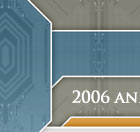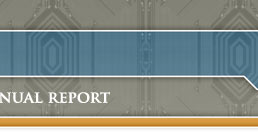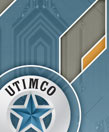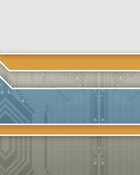 |
|
In last year’s Annual Report, the market environment for Fiscal Year 2005 was summarized as “Much Ado About Nothing”. In keeping with the Shakespearean reference, Fiscal Year 2006 can be described as “All’s Well That Ends Well”. During the year, the financial markets experienced:
- The end of the U.S. Federal Reserve tightening cycle, which lasted 17 rate increases totaling 425 bps (4.25%) with the initial Fed pause in August 2006,
- Oil prices advancing to an all-time high of $77/barrel, with a trough-to-peak move of +37% during the year,
- Dramatic declines in new home sales and housing starts, and
- Continuing geopolitical turmoil (Iraq, Afghanistan, North Korea, etc.).
|
|
 |
However, as the chapter is closed on another fiscal year, the performance results are reflective of a marketplace with a high degree of complacency related to these significant economic and political events. The S&P 500 appreciated by 8.9%, below its long term average of 10.4%, but a respectable return nonetheless. The Russell Mid and Small Cap indices were up over 9% each, their first single digit positive return results over the past five years (on an annualized basis), but once again, not a trivial result. Overseas, international equity markets surged ahead with developed international markets and emerging markets rising by 24.3% and 30.6%, respectively. Emerging markets have now extended their run of 30% or greater annualized returns to four consecutive years. REITs, which historically have shown sensitivity to a rising interest rates environment, nevertheless plowed higher, increasing by 26.3% during the fiscal year – extending their five year annualized return to in excess of 20%.
The global equity markets results were as strong as optimistic bull market pundits could have expected given the events during the year. “Risk” in the marketplace, as measured by the VIX Index (a volatility measure), declined to a level of 12 points, 45% lower than its 10 year average of 22 points. As equity markets move higher, volatility falls as market participants become more comfortable and more optimistic of the current economic environment and are willing to take on increasing levels of risk.
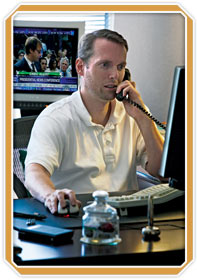 |
|
The risk-taking appetite can also be seen in the fixed income markets. The Lehman Aggregate Bond Index returned 1.7%; quite understandable given the rising interest rates environment since the value of bonds decreases as interest rates rise. However, high-yield and emerging market debt securities, which typically weaken as monetary conditions tighten, returned 7.9% and 9.0%, respectively.
Market performance over the course of the fiscal year can be evaluated by the significant changes to the price of oil. During the course of the year, the price of oil made higher highs on advances – and higher lows during declines, as complacency continued to grow in the energy marketplace.
|
The fiscal year began with the price of oil at a then all-time high of nearly $70/barrel and immediately reversed course falling to $56/barrel by mid-November. Investors pushed equity markets to calendar year highs as the welcome relief in energy prices would benefit corporate earnings and enable the continued advancement of global growth prospects. Market participants used the bearish short term news of strong oil and gas inventory injections, oil executives testifying in front of Congress on record profits, warmer than normal weather conditions in the U.S. and Europe, and concerns regarding slowing growth in Chinese energy demand as reasons to lock in profits for the year.
By the end of January 2006 the price per barrel of oil increased back to $70 as energy prices reversed course, and disruptions raised supply concerns while demand destruction had not become evident despite historically high prices. Equity markets, during this seasonally strong period, remained flat as investors supported equity prices, showing little concern over the cost of energy.
Oil then fell to $58/barrel by mid-February, down over $10/barrel in less than two weeks. Investors again rejoiced over lower energy prices, pushing equity markets again higher. However, falling energy prices were very short-lived, bottoming at $58/barrel and advancing to over $77/barrel by August 2006. Equity markets remained flattish during oil’s initial run to $70/barrel but then fell precipitously (erasing all calendar year-to-date gains and more) in June 2006. Equity markets, however, were resilient, and were able to turn around despite oil at $70+/barrel as the economic data showed a very supportive economy even as the Fed continued to hike interest rates.
Throughout the course of this advance and retreat of energy prices during the fiscal year, investors found opportunities in higher risk assets such as small cap equities, emerging markets and energy-related stocks.
In review of fiscal year 2006, when most investors reflect on the performance results posted by the financial markets, they are likely to conclude that “All’s Well That Ends Well” with positive results earned by asset classes and exceptional results from emerging market equities, non-U.S. developed international equities, REITs and private markets. For the endowment funds, the year was challenging as the portfolios were positioned defensively in anticipation for volatility to return to the financial system, but rewarding as the endowment funds obtained their fourth consecutive year of double digit results, as reflected in Figure B. However, only time will tell if all is really well for the global economy.
Portfolio returns are derived from the public markets, marketable alternatives, and private markets asset categories of the portfolios.

Public markets assets. The endowment funds ended the fiscal year with overweight positions, relative to the endowment policy portfolio, across most of the public market asset classes with the largest overweights in non-U.S. developed and emerging markets equities, REITs and commodities.
Defensive positioning of the U.S., non-U.S. developed and emerging market equity portfolios led to relative underperformance of these portfolios when compared to their respective benchmarks. The PUF U.S. equities portfolio earned a return of 8.10%, while the GEF’s portfolio generated a return of 8.46%, both which lagged the Russell 3000 Index return of 8.75%. The PUF and GEF non-U.S. developed equity portfolios earned returns of 20.23% and 19.95%, respectively, but underperformed the MSCI EAFE Index return of 24.28%. The emerging markets portfolios also struggled versus the 30.58% earned by the MSCI Emerging Markets Index generating returns of 22.29% and 21.79%, respectively, for the PUF and GEF.

Click to print charts in this section using PDF format
REITs, the strongest performing asset class, led the inflation linked asset category with the PUF’s return of 28.04% and the GEF’s return of 27.92% outperforming the Dow Jones Wilshire Real Estate Securities Index return of 26.34% for the fiscal period. The PUF and GEF TIPS portfolios also outperformed their benchmark, the Lehman Brothers U.S. TIPS Index, as they earned returns of 2.06% for the twelve month period ended August 31, 2006, compared to the 1.52% index return. The PUF and GEF commodities portfolios earned the only negative returns, -4.56% and -4.57%, respectively, for the fiscal period, ahead of their benchmark return which was down -6.76%.
Marketable alternatives assets. The endowment funds’ marketable alternatives assets (hedge funds) portfolio generated a 7.86% return for the fiscal year. Annualized volatility of the portfolio remained low at 3.75% for the one-year period and 5.09% for the five-year period, compared to that of the S&P 500 at 6.28% and 13.29%, respectively. Facing challenging global capital markets, the portfolio experienced only three down months during the 12-month period, posting a loss of
-1.40% in October 2005, a loss of -1.15% in May 2006, and a modest loss of -0.21% in June 2006. With fears of slowing global growth and mounting risk aversion among investors, international equity markets were particularly volatile during these months with the MSCI All Country World (ex-U.S.) index down more than -3.64% in October 2005 and down
-4.71% in May 2006. True to its diversification, the portfolio’s losses were muted relative to broader market indices during these volatile periods.
Absolute return investments, representing 66% of the marketable alternatives portfolio, primarily include multi-strategy managers focused on arbitrage and event-driven strategies such as special situation equities, distressed debt, equity market neutral, and various arbitrage strategies. Including new managers added during the fiscal year, these managers continued to increase their diversification by increasing allocations to private equity and global (ex-U.S.) special situation equities, as well as fixed income (ex-distressed) strategies. The absolute return managers posted a return of 9.00% for the period.
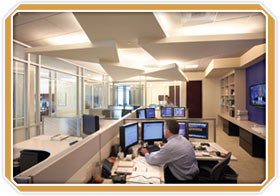 |
|
Directional investments, representing 34% of the marketable alternatives portfolio, include both domestic and global (ex-U.S.) long/short equity managers who extract profits through stock selection skills by taking long and short positions in various equity securities. Including new managers added during the fiscal year, domestic and global (ex-US) allocations, 65% and 35% respectively of directional investments, remained consistent during the period. The directional managers posted a return of 6.21% for the fiscal year.
|
During the fiscal year, investment activity was robust with the launch of the Intermediate Term Fund in February 2006, as well as active portfolio rebalancing activities. Approximately $1.1 billion in net capital allocations were completed, comprised of $1.3 billion in subscriptions and over $200 million in full and partial redemptions. Ten new hedge fund manager relationships and 16 new mandates were added during the fiscal year, while two hedge fund relationships were terminated. As of August 31, 2006, the marketable alternatives portfolio had 31 active relationships across 42 mandates. The ten largest relationships represented approximately 68% of invested capital. The marketable alternatives team will continue to critically analyze new investment opportunities and to rigorously evaluate existing hedge fund mandates to ensure strong, long-term portfolio performance.
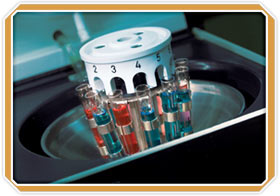 |
Private markets assets. The endowment
funds’ private market assets consist primarily of venture capital and buyout funds. For the third straight year, the private portfolio generated impressive returns. On an absolute basis, the PUF and GEF portfolios produced time-weighted returns of 23.02% and 21.77%, respectively. For the third straight year, the endowments benefited greatly from a strong debt market which continued to fuel mergers and acquisitions activity.
|
As a result, UTIMCO’s U.S. and European buyout funds were able to sell many of their portfolio companies at significant profits and return cash to the endowment funds. As in recent years, UTIMCO’s venture capital funds generated modest returns in 2006. The endowments’ managers continued to invest in and develop companies based on exciting new technologies, but the capital markets did not allow for many exits of venture-backed companies.
The UTIMCO staff has high expectations for the endowments’ venture capital portfolio, but acknowledges that stated returns will not improve dramatically until the initial public offering (IPO) markets improve for venture-backed companies.
In addition to producing positive returns for the year, UTIMCO’s private equity funds also produced a record amount of cash for the endowments. Specifically, UTIMCO’s general partners distributed $564.8 million in cash and securities to the PUF and GEF, combined, during fiscal year 2006. As a result of those distributions and the overall growth of the PUF and GEF portfolios, the endowments’ combined exposure to private equity investments was 9.97% of total assets, significantly below the 15.0% target for this category. To increase the endowments’ exposure to private equity, the Private Markets staff committed $977 million to new venture capital, distressed debt, and buyout funds during the year. At year-end, the staff managed a portfolio that included 166 limited partnerships that were, in turn, managed by 88 different general partners.

As outlined earlier, the private market investments generated solid absolute performance in the fiscal year. On a relative basis, performance was mixed in 2006. UTIMCO compares the time-weighted returns on the PUF and GEF portfolios to the time-weighted return of the Venture Economics benchmark. For the year ending August 31, 2006, the PUF (+23.02%) and GEF (+21.77) under-performed the Venture Economics benchmark, which returned 26.23% for that same period. The staff believes the endowments’ portfolios under-performed this benchmark because they are immature when compared to the benchmark, which is comprised of funds that are older, on average, than the endowments’ private portfolios. The staff also assesses the relative performance of the portfolio by comparing actual since inception returns (IRR) to the returns the endowments would have earned had they invested their private equity dollars in the public markets. As of August 31, 2006, the endowments’ since inception IRR was 12.42%, up from 11.71% a year earlier. Had the endowments invested all of their private equity dollars into the Russell 3000 benchmark, the annualized return over more than two decades would have been only 5.79%. As a result, UTIMCO’s private equity investments have produced 6.63% per year in incremental returns for the endowments since 1983, and this out-performance has resulted in cumulative value-added of more than $957 million.
|

